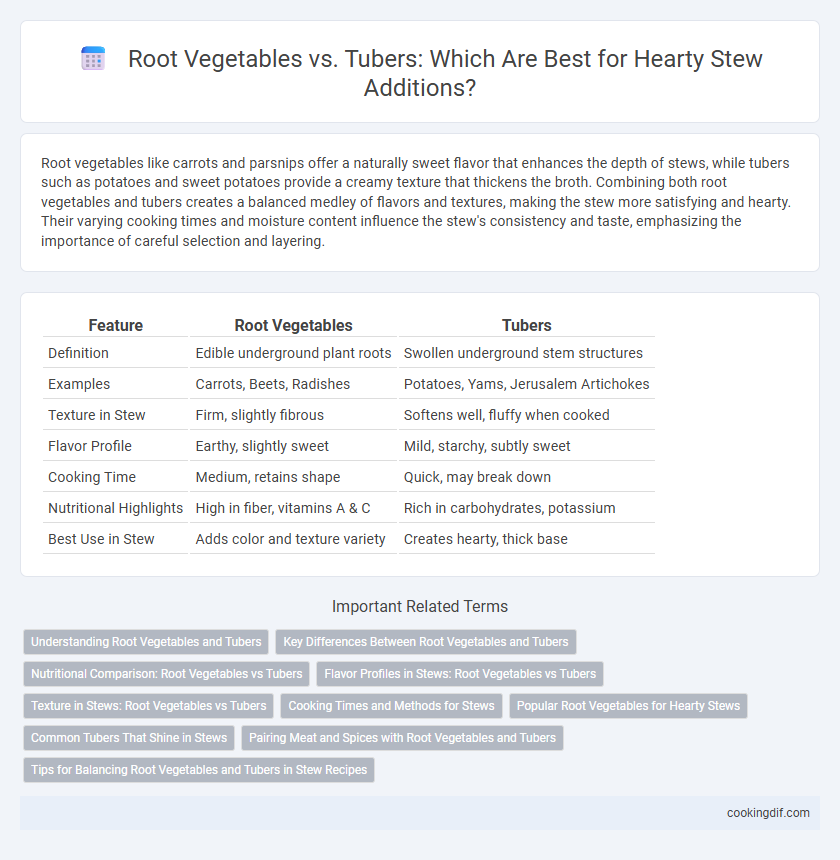Root vegetables like carrots and parsnips offer a naturally sweet flavor that enhances the depth of stews, while tubers such as potatoes and sweet potatoes provide a creamy texture that thickens the broth. Combining both root vegetables and tubers creates a balanced medley of flavors and textures, making the stew more satisfying and hearty. Their varying cooking times and moisture content influence the stew's consistency and taste, emphasizing the importance of careful selection and layering.
Table of Comparison
| Feature | Root Vegetables | Tubers |
|---|---|---|
| Definition | Edible underground plant roots | Swollen underground stem structures |
| Examples | Carrots, Beets, Radishes | Potatoes, Yams, Jerusalem Artichokes |
| Texture in Stew | Firm, slightly fibrous | Softens well, fluffy when cooked |
| Flavor Profile | Earthy, slightly sweet | Mild, starchy, subtly sweet |
| Cooking Time | Medium, retains shape | Quick, may break down |
| Nutritional Highlights | High in fiber, vitamins A & C | Rich in carbohydrates, potassium |
| Best Use in Stew | Adds color and texture variety | Creates hearty, thick base |
Understanding Root Vegetables and Tubers
Root vegetables and tubers both provide hearty, nutrient-rich additions to stews, but they differ botanically and in culinary use. Root vegetables, such as carrots, parsnips, and beets, develop from the plant's primary root and are rich in vitamins and fiber, enhancing flavor depth and texture. Tubers like potatoes, sweet potatoes, and yams store energy underground in swollen stems or roots, offering a creamy consistency and a starchy, filling element that thickens and enriches stews.
Key Differences Between Root Vegetables and Tubers
Root vegetables such as carrots, beets, and turnips grow as edible roots beneath the soil, providing natural sweetness and fibrous texture ideal for stews. Tubers, including potatoes and yams, are thickened underground stems that store starch, offering a dense, creamy consistency that thickens and enriches hearty dishes. Understanding these key differences helps select the right vegetables for flavor balance and texture in robust stew recipes.
Nutritional Comparison: Root Vegetables vs Tubers
Root vegetables such as carrots, beets, and parsnips offer high fiber, vitamins A and C, and antioxidants that support immune health and digestion. Tubers like potatoes, sweet potatoes, and yams provide significant amounts of complex carbohydrates, potassium, and vitamin B6, delivering sustained energy and nerve function benefits. Choosing a mix of both root vegetables and tubers maximizes nutritional variety and enhances the heartiness of your stew.
Flavor Profiles in Stews: Root Vegetables vs Tubers
Root vegetables such as carrots, parsnips, and turnips offer a sweet, earthy flavor that deepens the stew's complexity, while tubers like potatoes and yams provide a mild, starchy base that enhances texture and richness. The natural sugars in root vegetables caramelize during slow cooking, adding subtle sweetness and robust aroma, contrasting with the creamy, silky mouthfeel contributed by tubers. Choosing between root vegetables and tubers influences the stew's overall flavor balance, with roots delivering intense, layered tastes and tubers offering smooth, hearty comfort.
Texture in Stews: Root Vegetables vs Tubers
Root vegetables like carrots and parsnips provide a firm, slightly fibrous texture that holds up well during long simmering, adding a subtle crunch to stews. Tubers such as potatoes and sweet potatoes soften more uniformly, creating a creamy consistency that thickens the broth and enriches mouthfeel. Balancing root vegetables and tubers in stews ensures a dynamic texture profile, combining firmness with smoothness for a satisfying, hearty experience.
Cooking Times and Methods for Stews
Root vegetables like carrots and parsnips typically require longer cooking times in stews to become tender, usually simmering for 45 to 60 minutes. Tubers such as potatoes and sweet potatoes soften more quickly, often cooking through in 20 to 30 minutes when added at the right stage. Using a combination of both root vegetables and tubers can enhance stew texture, balancing the firmer bite of roots with the creamy consistency of tubers after proper simmering.
Popular Root Vegetables for Hearty Stews
Carrots, parsnips, and turnips are popular root vegetables that add rich flavor and texture to hearty stews. These root vegetables release natural sweetness and absorb spices well, enhancing the overall depth of the dish. Their firm flesh withstands long cooking times, ensuring a satisfying bite in every spoonful.
Common Tubers That Shine in Stews
Common tubers that shine in stews include potatoes, sweet potatoes, and yams, prized for their creamy texture and ability to absorb flavors. These tubers provide a hearty, satisfying base that thickens the stew naturally, adding both nutrition and depth. Unlike root vegetables such as carrots or parsnips, tubers store more starch, making them ideal for rich, comforting stew recipes.
Pairing Meat and Spices with Root Vegetables and Tubers
Root vegetables like carrots, parsnips, and turnips offer a sweet earthiness that complements robust meats such as beef, lamb, and pork in stews. Tubers like potatoes, sweet potatoes, and yams provide a creamy texture that balances spicy, aromatic seasonings including garlic, rosemary, and smoked paprika. Combining these root vegetables and tubers with bold meat cuts enhances both flavor and nutritional depth in hearty stew recipes.
Tips for Balancing Root Vegetables and Tubers in Stew Recipes
Root vegetables like carrots, parsnips, and turnips offer a sweet, earthy flavor and firm texture that hold up well during long simmering, while tubers such as potatoes, yams, and sweet potatoes provide creamy, starchy qualities that thicken stews naturally. Balancing these components involves cutting root vegetables into larger chunks to prevent them from becoming mushy, and adding tubers mid-cooking to maintain their structure. Incorporating a variety of both enhances flavor complexity and nutritional value, giving stews a rich, satisfying depth.
Root vegetables vs tubers for hearty additions Infographic

 cookingdif.com
cookingdif.com